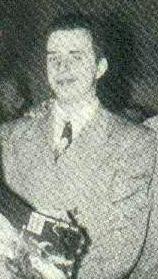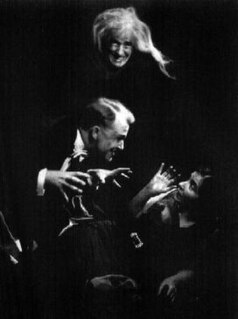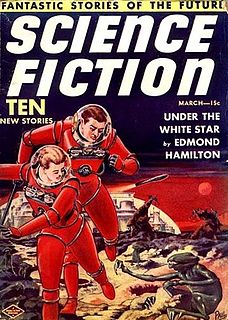
Weird Tales is an American fantasy and horror fiction pulp magazine founded by J. C. Henneberger and J. M. Lansinger in late 1922. The first issue, dated March 1923, appeared on newsstands February 18. The first editor, Edwin Baird, printed early work by H. P. Lovecraft, Seabury Quinn, and Clark Ashton Smith, all of whom would go on to be popular writers, but within a year the magazine was in financial trouble. Henneberger sold his interest in the publisher, Rural Publishing Corporation, to Lansinger and refinanced Weird Tales, with Farnsworth Wright as the new editor. The first issue under Wright's control was dated November 1924. The magazine was more successful under Wright, and despite occasional financial setbacks it prospered over the next fifteen years. Under Wright's control the magazine lived up to its subtitle, "The Unique Magazine", and published a wide range of unusual fiction.

Unknown was an American pulp fantasy fiction magazine, published from 1939 to 1943 by Street & Smith, and edited by John W. Campbell. Unknown was a companion to Street & Smith's science fiction pulp, Astounding Science Fiction, which was also edited by Campbell at the time; many authors and illustrators contributed to both magazines. The leading fantasy magazine in the 1930s was Weird Tales, which focused on shock and horror. Campbell wanted to publish a fantasy magazine with more finesse and humor than Weird Tales, and put his plans into action when Eric Frank Russell sent him the manuscript of his novel Sinister Barrier, about aliens who own the human race. Unknown's first issue appeared in March 1939; in addition to Sinister Barrier, it included H. L. Gold's "Trouble With Water", a humorous fantasy about a New Yorker who meets a water gnome. Gold's story was the first of many in Unknown to combine commonplace reality with the fantastic.

Planet Stories was an American pulp science fiction magazine, published by Fiction House between 1939 and 1955. It featured interplanetary adventures, both in space and on some other planets, and was initially focused on a young readership. Malcolm Reiss was editor or editor-in-chief for all of its 71 issues. Planet Stories was launched at the same time as Planet Comics, the success of which probably helped to fund the early issues of Planet Stories. Planet Stories did not pay well enough to regularly attract the leading science fiction writers of the day, but occasionally obtained work from well-known authors, including Isaac Asimov and Clifford D. Simak. In 1952 Planet Stories published Philip K. Dick's first sale, and printed four more of his stories over the next three years.

The Haunt of Fear was an American bi-monthly horror comic anthology series published by EC Comics, starting in 1950. Along with Tales from the Crypt and The Vault of Horror, it formed a trifecta of popular EC horror anthologies. The Haunt of Fear was sold at newsstands beginning with its May/June 1950 issue. It ceased publication with its November/December 1954 issue, compiling a total of 28 issues.

Robert Augustine Ward "Doc" Lowndes was an American science fiction author, editor and fan. He was known best as the editor of Future Science Fiction, Science Fiction, and Science Fiction Quarterly, among many other crime-fiction, western, sports-fiction, and other pulp and digest sized magazines for Columbia Publications. Among the most famous writers he was first to publish at Columbia was mystery writer Edward D. Hoch, who in turn would contribute to Lowndes's fiction magazines as long as he was editing them. Lowndes was a principal member of the Futurians. His first story, "The Outpost at Altark" for Super Science in 1940, was written in collaboration with fellow Futurian Donald A. Wollheim, uncredited.

The Witch's Tale is a horror-fantasy radio series which aired from May 21, 1931, to June 13, 1938, on WOR, the Mutual Radio Network, and in syndication. The program was created, written, and directed by Alonzo Deen Cole.
Michael Raymond Donald Ashley is a British bibliographer, author and editor of science fiction, mystery, and fantasy.

Tales of Wonder was a British science fiction magazine published from 1937 to 1942, with Walter Gillings as editor. It was published by The World's Work, a subsidiary of William Heinemann, as part of a series of genre titles that included Tales of Mystery and Detection and Tales of the Uncanny. Gillings was able to attract some good material, despite the low payment rates he was able to offer; he also included many reprints from U.S. science fiction magazines. The magazine was apparently more successful than the other genre titles issued by The World's Work, since Tales of Wonder was the only one to publish more than a single issue.
Uncanny Tales was a Canadian science fiction pulp magazine edited by Melvin R. Colby that ran from November 1940 to September 1943. It was created in response to the wartime reduction of imports on British and American science-fiction pulp magazines. Initially it contained stories only from Canadian authors, with much of its contents supplied by Thomas P. Kelley, but within a few issues Colby began to obtain reprint rights to American stories from Donald A. Wollheim and Sam Moskowitz. Paper shortages eventually forced the magazine to shut down, and it is now extremely rare.

Science-Fiction Plus was an American science fiction magazine published by Hugo Gernsback for seven issues in 1953. In 1926, Gernsback had launched Amazing Stories, the first science fiction magazine, but he had not been involved in the genre since 1936, when he sold Wonder Stories. Science-Fiction Plus was initially in slick format, meaning that it was large-size and printed on glossy paper. Gernsback had always believed in the educational power of science fiction, and he continued to advocate his views in the new magazine's editorials. The managing editor, Sam Moskowitz, had been a reader of the early pulp magazines, and published many writers who had been popular before World War II, such as Raymond Z. Gallun, Eando Binder, and Harry Bates. Combined with Gernsback's earnest editorials, the use of these early writers gave the magazine an anachronistic feel.

Fantastic Story Quarterlywas a pulp science fiction magazine, published from 1950 to 1955 by Best Books, a subsidiary imprint of Standard Magazines. The name was changed with the Summer 1951 issue to Fantastic Story Magazine. It was launched to reprint stories from the early years of the science fiction pulp magazines, and was initially intended to carry no new fiction, though in the end every issue contained at least one new story. It was sufficiently successful for Standard to launch Wonder Story Annual as a vehicle for more science fiction reprints, but the success did not last. In 1955 it was merged with Standard's Startling Stories. Original fiction in Fantastic Story included Gordon R. Dickson's first sale, "Trespass", and stories by Walter M. Miller and Richard Matheson.

Famous Fantastic Mysteries was an American science fiction and fantasy pulp magazine published from 1939 to 1953. The editor was Mary Gnaedinger. It was launched by the Munsey Company as a way to reprint the many science fiction and fantasy stories which had appeared over the preceding decades in Munsey magazines such as Argosy. From its first issue, dated September/October 1939, Famous Fantastic Mysteries was an immediate success. Less than a year later, a companion magazine, Fantastic Novels, was launched.

Future Science Fiction and Science Fiction Stories were two American science fiction magazines that were published under various names between 1939 and 1943 and again from 1950 to 1960. Both publications were edited by Charles Hornig for the first few issues; Robert W. Lowndes took over in late 1941 and remained editor until the end. The initial launch of the magazines came as part of a boom in science fiction pulp magazine publishing at the end of the 1930s. In 1941 the two magazines were combined into one, titled Future Fiction combined with Science Fiction, but in 1943 wartime paper shortages ended the magazine's run, as Louis Silberkleit, the publisher, decided to focus his resources on his mystery and western magazine titles. In 1950, with the market improving again, Silberkleit relaunched Future Fiction, still in the pulp format. In the mid-1950s he also relaunched Science Fiction, this time under the title Science Fiction Stories. Silberkleit kept both magazines on very slim budgets throughout the 1950s. In 1960 both titles ceased publication when their distributor suddenly dropped all of Silberkleit's titles.

Marvel Science Stories was an American pulp magazine that ran for a total of fifteen issues in two separate runs, both edited by Robert O. Erisman. The publisher for the first run was Postal Publications, and the second run was published by Western Publishing; both companies were owned by Abraham and Martin Goodman. The first issue was dated August 1938, and carried stories with more sexual content than was usual for the genre, including several stories by Henry Kuttner, under his own name and also under pseudonyms. Reaction was generally negative, with one reader referring to Kuttner's story "The Time Trap" as "trash". This was the first of several titles featuring the word "Marvel", and Marvel Comics came from the same stable in the following year.

Fantasy was a British pulp science fiction magazine which published three issues in 1938 and 1939. The editor was T. Stanhope Sprigg; when the war started, he enlisted in the RAF and the magazine was closed down. The publisher, George Newnes Ltd, paid respectable rates, and as a result Sprigg was able to obtain some good quality material, including stories by John Wyndham, Eric Frank Russell, and John Russell Fearn.

Strange Tales was an American pulp magazine first published from 1931 to 1933 by Clayton Publications. It specialized in fantasy and weird fiction, and was a significant competitor to Weird Tales, the leading magazine in the field. Its published stories include "Wolves of Darkness" by Jack Williamson, as well as work by Robert E. Howard and Clark Ashton Smith. The magazine ceased publication when Clayton entered bankruptcy. It was temporarily revived by Wildside Press, which published three issues edited by Robert M. Price from 2003 to 2007.

Ghost Stories was an American pulp magazine that published 64 issues between 1926 and 1932. It was one of the earliest competitors to Weird Tales, the first magazine to specialize in the fantasy and occult fiction genre. It was a companion magazine to True Story and True Detective Stories, and focused almost entirely on stories about ghosts, many of which were written by staff writers but presented under pseudonyms as true confessions. These were often accompanied by faked photographs to make the stories appear more believable. Ghost Stories also had original and reprinted contributions, including works by Robert E. Howard, Carl Jacobi, and Frank Belknap Long. Among the reprints were Agatha Christie's "The Last Seance", several stories by H.G. Wells, and Charles Dickens's "The Signal-Man". Initially successful, the magazine began to lose readers and in 1930 was sold to Harold Hersey. Hersey was unable to reverse the magazine's decline, and publication of Ghost Stories ceased in early 1932.

Wonder Story Annual was a science fiction pulp magazine which was launched in 1950 by Standard Magazines. It was created as a vehicle to reprint stories from early issues of Wonder Stories, Startling Stories, and Wonder Stories Quarterly, which were owned by the same publisher. It lasted for four issues, succumbing in 1953 to competition from the growing market for paperback science fiction. Reprinted stories included Twice in Time, by Manly Wade Wellman, and "The Brain-Stealers of Mars", by John W. Campbell.

Science-fiction and fantasy magazines began to be published in the United States in the 1920s. Stories with science-fiction themes had been appearing for decades in pulp magazines such as Argosy, but there were no magazines that specialized in a single genre until 1915, when Street & Smith, one of the major pulp publishers, brought out Detective Story Magazine. The first magazine to focus solely on fantasy and horror was Weird Tales, which was launched in 1923, and established itself as the leading weird fiction magazine over the next two decades; writers such as H.P. Lovecraft, Clark Ashton Smith and Robert E. Howard became regular contributors. In 1926 Weird Tales was joined by Amazing Stories, published by Hugo Gernsback; Amazing printed only science fiction, and no fantasy. Gernsback included a letter column in Amazing Stories, and this led to the creation of organized science-fiction fandom, as fans contacted each other using the addresses published with the letters. Gernsback wanted the fiction he printed to be scientifically accurate, and educational, as well as entertaining, but found it difficult to obtain stories that met his goals; he printed "The Moon Pool" by Abraham Merritt in 1927, despite it being completely unscientific. Gernsback lost control of Amazing Stories in 1929, but quickly started several new magazines. Wonder Stories, one of Gernsback's titles, was edited by David Lasser, who worked to improve the quality of the fiction he received. Another early competitor was Astounding Stories of Super-Science, which appeared in 1930, edited by Harry Bates, but Bates printed only the most basic adventure stories with minimal scientific content, and little of the material from his era is now remembered.

Thorpe & Porter was a British publisher, importer, and distributor of magazines and comic books. At first, the company was known for repackaging American comics and pulp magazines for the UK market. Later on, it became a publisher of original material. The company released more than 160 comics titles in the UK, the most prominent being Classics Illustrated, MAD UK, Edgar Rice Burroughs' Tarzan of the Apes, Larry Harmon's Laurel & Hardy, House of Hammer, and Forbidden Worlds. T & P's most prominent imprints were Top Sellers Ltd. and Brown Watson. Thorpe & Porter operated from 1946 to c. 1979.



















